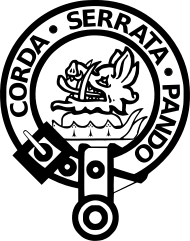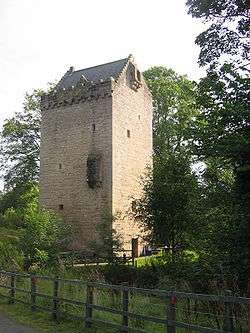Clan Lockhart
| Clan Lockhart | |||
|---|---|---|---|
 | |||
| Motto | Corda Serrata Pando (I open locked hearts - a pun on the clan name)[1] | ||
| Profile | |||
| Region | Lowlands | ||
| District | Lanarkshire | ||
| Chief | |||
 | |||
| Angus Hew Lockhart of the Lee | |||
| Chief of the Name and Arms of Lockhart | |||
| Historic seat | Lee Castle | ||
| |||
Clan Lockhart is a Lowland Scottish clan.[2]
History
Origins of the clan
The name Lockhart was spelt Locard or Lokart in early times.[2] Like many other Scottish families the Locards came from England to Scotland after they had been dispossessed of lands by William the Conqueror.[2] In the twelfth century there were Lockards near Penrith and later in Annandale.[2] In Annandale the town of Lockerbie is said to have been named after them.[2] The chiefly family finally settled Ayrshire and Lanarkshire where they have held lands for over seven hundred years.[2]
A charter of 1323 is the earliest paper in the family archives, in which Sir Symon Locard bound himself and his heirs to pay an annual rent of £10 out of the lands of Lee and Cartland, South Lanarkshire.[2] Sir Symon's grandfather, Stephen Locard, founded the village of Stevenson in Ayrshire.[2] His son, Symon, held lands in Ayrshire and founded a village called Symons Toun, which is today called Symington.[2]
Wars of Scottish Independence and the Crusades

Symon Locard, 2nd of Lee, won fame for himself and his family in the Wars of Scottish Independence against the English when he fought alongside king Robert the Bruce and was knighted for his loyal service.[2] Sir Symon accompanied 'Good Sir James Douglas' of the Clan Douglas when he took the heart of Robert the Bruce on the crusades in 1330.[2] It was Sir Symon who carried the key to the casket in which the heart was carried.[2] Symon rescued the casket and heart and returned it to Scotland after James Douglas had been killed in Spain fighting the Moors.[2] A heart with a fetterlock was from then on included in the chief's arms and also the deed is commemorated in the clan motto.[2]
The Lee Penny
During the crusades of the 14th century the Lockharts brought back a precious heirloom.[2] It is known as the "Lee Penny".[2] Sir Simon Lockhart captured a Moorish amir in battle and received from the man's mother as part of his ransom an amulet or stone with healing powers.[2] The amir's mother told Sir Simon that the stone was a sovereign remedy against bleeding and fever, the bite of a mad dog, and sickness in horses and cattle.[2] It was later set in a silver coin which has now been identified as a fourpenny piece from the reign of King Edward IV.[2] The Lee Penny is kept in a gold snuffbox which was a gift from Maria Theresa of Austria, Empress of Austria to her general Count James Lockhart in 1789.[2]
The fame of the Lee Penny spread through Scotland and Northern England and there are many recorded occasions when it was employed with apparent success. The coin was exempted from the Church of Scotland's prohibition on charms and was lent to the citizens of Newcastle during the reign of King Charles I to protect them from the plague. A sum of between £1000 and £6000 was pledged for its return.[3] The penny gained further fame in the 19th century for inspiring Sir Walter Scott's 1825 novel The Talisman.[2][4]
16th and 17th centuries

In 1547 Alan Lockhart of Lee was killed at the Battle of Pinkie Cleugh.[2] Sir James Lockhart of Lee (b.1594) was appointed by Charles I of England as a gentleman of the Privy Council and was knighted.[2] He was also appointed to the Supreme Court Bench taking the title of Lord Lee.[2]
Civil War
During the Wars of the Three Kingdoms he was a zealous royalist and was captured at Alyth in 1651.[2] His son was Sir William Lockhart of Lee who was a distinguished soldier and fought at the Battle of Worcester as a royalist in 1651.[2] However he later reconciled with Oliver Cromwell and married Cromwell's niece.[2] As a result, he was not in favour with the Stuart monarchs when they were restored in 1660 and made his home in France.[2] He later campaigned on the continent and Cardinal Mazarin offered to make him mareshcal of France.[2]
Sir George Lockhart (1630–1689) was the second son of Sir James Lockhart, Lord Lee, Lord Justice Clerk and became one of the most famous advocates at the Edinburgh Bar. He became Lord President of the Court of Session in 1685 and was M.P. for Lanarkshire in both the English and Scottish Parliaments. His knighthood was conferred in 1663 and the Carnwath and Dryden estates acquired by him in 1681. He was murdered on Easter Sunday 1689 on his way home from church by a dissatisfied litigant named Chiesly of Kersewell and Dalry.
18th century and Jacobite risings
George Lockhart, Second of Carnwath (1673–1731) was a fervent Jacobite; he became Principal Agent to the exiled King James after the Jacobite rising of 1715. He was one of the Commissioners for the Treaty of Union, and the only one against it. He was one of the earliest of the agricultural improvers. He married Euphemia Montgomery, daughter of the ninth Earl of Eglinton; they had fourteen children. He died as the result of a duel.
James Lockhart inherited the estates in 1777 and saw service on the continent where he rose to become a count of the Order of Maria Theresa and a general of that empress's imperial forces.[2]
Clan Chief
Chief: Ranald Lockhart of the Lee, Chief of the Name and Arms of Lockhart.
Clan Castle
The seat of the Chief of the Clan Lockhart was at Lee Castle near Lanark, but have since passed out of Lockhart hands.[2] However the present chief still manages substantial lands at nearby Carnwath.[2]
References
- Clan Lockhart Profile scotclans.com. Retrieved 13 October 2013.
- Way, George and Squire, Romily. Collins Scottish Clan & Family Encyclopedia. (Foreword by The Rt Hon. The Earl of Elgin KT, Convenor, The Standing Council of Scottish Chiefs). Published in 1994. Pages 198 - 199.
- Westwood, Jennifer and Kingshill, Sophia (2009). The Lore of Scotland. A guide to Scottish Legends. London : Random House. ISBN 978-1-905211-62-3 p. 192
- James Y. Simpson, Archaeological Essays, Vol. 1, 1872, p. 215